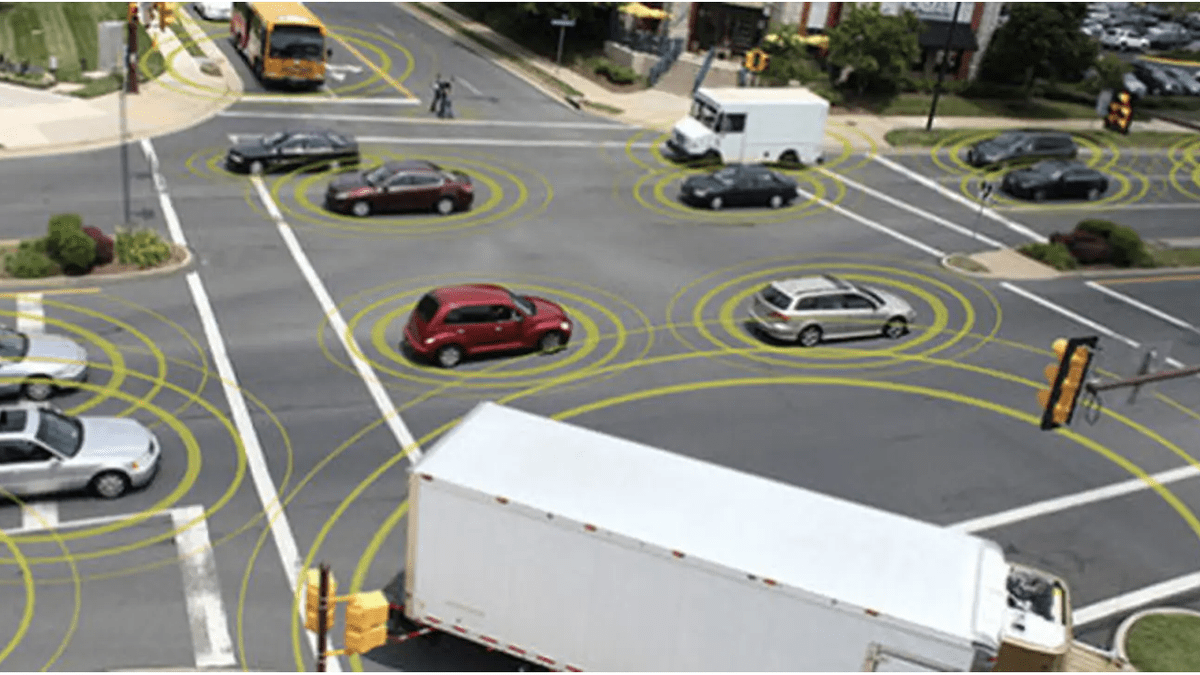Self-Driving Car Tech Forgotten by Automakers Is Still Kept Alive by Federal Agency

Graphic: NHTSA
There was a time when the answer to how to make self-driving cars work was to design a singular technology that would allow every vehicle on the road to communicate with everything — other cars, pieces of infrastructure, signs, police alerts, you name it. You don’t hear much about vehicle-to-vehicle (V2V) or vehicle-to-everything (V2X) communication anymore, but the feds are keeping it alive through a similar concept: cellular vehicle-to-vehicle communications.
First, I’d like to take you back now, to the year 1999. Backstreet Boys have just hit the airwaves with their mega single “I Want It That Way,” and Star Wars was reintroduced to a generation via The Phantom Menace. It’s also the year the Federal Communications Commission set aside the 5.9 GHz band specifically to allow cars to talk to each other and the world.
You might remember hearing about this a lot over the last two decades, but not so much in the last few years. LiDar and cameras now dominate the developing self-driving technology, but V2V was once considered critical to making the leap to a fully autonomous driving experience.
Back in 2016, the National Highway Traffic Safety Administration published a Notice of Proposed Rule that all vehicles should be fitted with a Dedicated Short Range Communication system for V2X communication. A DSRC would allow vehicles to communicate between each other and with traffic elements up to 300 meters on that dedicated 5.9 GHz bandwidth.
But after years of holding the band for automakers and no movement towards an industry-wide system, the FCC decided to hand some of that band over to Wi-Fi instead, Ars Technica reports. It didn’t sign over the whole band, however. In a letter sent Monday the National Transportation Safety Board is pushing the FCC to allow the new C-V2X technology to begin testing. C-V2X would allow vehicles to communicate to each other via cellular radio protocols, rather than a dedicated short-range radio signal:
This has dismayed the NTSB, which has written to the FCC as part of the commission’s public comment period as it considers a waiver requested by automakers to deploy C-V2X technology. Conceptually, C-V2X works the same as the older V2X—direct vehicle-to-vehicle or vehicle-to-infrastructure communication but using cellular radio protocols instead of the dedicated short-range radio communication protocol.
The FCC should grant this waiver, said the NTSB, which notes in its letter that it has recommended that the nation adopt wireless-based collision-avoidance technology since 1995. Connected vehicle technology would reduce the ever-escalating carnage on US roads, said the NTSB, and the agency also urged the FCC to make sure that Wi-Fi devices don’t encroach on the remaining 30 MHz of intelligent transportation system frequencies.
“30 MHz is enough for basic safety features,” said Balázs Tóth-Pintér, a communications specialist with V2X company Commsignia, who pointed out that the EU has only allocated a total of 40 MHz for V2X. And unlike in the US, deployment is happening in Europe. “This year, we’ll see approximately 1 million V2X cars in Europe. The expected penetration will be in the 10 million-ish range by around 2024–2025,” he told Ars.
Tóth-Pintér also noted that the court’s decision only added clarity to the field and that Commsignia has “been working on that 30 MHz since the FCC made its decision almost two years ago. We deliver equipment with both DSRC and C-V2X included, so changing the physical network layer is not a big issue. Now we can go full speed ahead with deployments,” he said.
G/O Media may get a commission
28% Off
Apple AirPods Pro Wireless Earbuds
Music+
These are the pinnacle of Apple AirPod design, and feature active noise cancelling, a transparency mode for when you need to hear what’s around you, spatial audio for accuracy, adaptive EQ, and are even sweat resistant.
It’s clear why vehicle-to-everything technology hasn’t really caught on in the U.S., besides General Motors putting DSRCs in 2017 Cadillac CTS sedans and building a tiny stretch of connected freeway outside of Detroit to test it. To successfully implement V2X or even C-V2X, we’d need massive investment in infrastructure and a whole new suite of standards and regulations that would impact the auto industry across diverse markets, both in the U.S. and abroad. It would require new industries of programing and sensor building to spring up and compete for contracts and federal funds for every state to be allotted and dispersed.
Meanwhile, for the last four years under the Trump administration NHTSA did pretty much nothing and certainly wasn’t up for battling automakers over the rules and regulations for a whole new frontier of technology.
Automakers haven’t waited for the feds to get it together; they’ve moved the technology forward using LiDar, cameras, sensors and other elements that are contained to each individual car. In doing so, automakers have turned drivers who share the road with their products into unknowing beta testers and imagined technologies that put their products and customers first, totally incongruous with the goal of building safer cities for everyone. And fed inaction over the last six years has made our roads less safer than ever before. When V2X technology was the hot tech to bet on back in 2016, for instance 37,000 Americans died in traffic accidents. In 2021, that number was 43,000.
NTSB’s plea just seems like an attempt to keep a dream of safer streets through better technology alive. These folks should really consider what the world will look like if self-driving cars never happen at all. We don’t need V2X or C-V2X to make our roads safer of course, but the solutions for cutting down on road deaths just strikes Americans as kinda a hassle.




